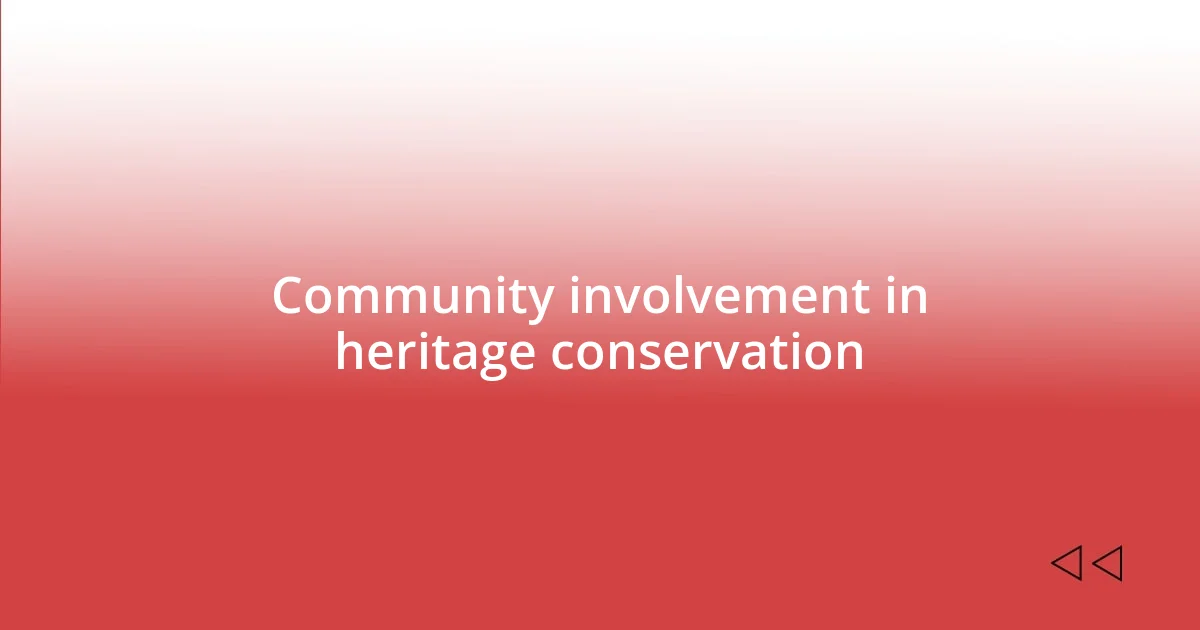Key takeaways:
- Authenticity is crucial in heritage conservation, requiring a balance between preserving original character and adapting to modern needs.
- Community involvement enhances conservation efforts by fostering a sense of ownership, generating innovative ideas, and encouraging diverse voices in decision-making.
- Preserving cultural heritage supports economic growth by attracting tourism and emphasizing the importance of local history and traditions.

Understanding heritage conservation principles
Heritage conservation principles stem from a deep appreciation for history and culture, which can be overwhelming at times. I still remember the excitement I felt while participating in the restoration of a local historic building; it was like stepping back in time. Isn’t it fascinating how each brick tells a story, connecting us with generations before us?
One key principle revolves around authenticity. It’s not just about preserving structures; it’s about maintaining their original character and significance. During my experience, I discovered how easy it is to lose sight of this when modern interventions creep in. Have you ever visited a place and felt something was off? That disconnect often arises when authenticity is compromised in favor of convenience.
Moreover, understanding the historical context of a site enhances its value. I was once involved in a project where we uncovered documents revealing the original purpose of a building, transforming how we approached its conservation. This revelation sparked great discussions among our team. It made me wonder, how often do we overlook the stories waiting to be unearthed in our own neighborhoods? Each site has its narrative, and recognizing this is crucial for effective heritage conservation.

Importance of preserving cultural heritage
The preservation of cultural heritage plays a vital role in maintaining our collective identity. Each monument, tradition, and artifact is a thread in the fabric of our society. I recall a day spent at a local festival celebrating an age-old tradition where families gathered, sharing stories and laughter. It made me realize how such events not only connect us to our roots but also foster community bonds that are often taken for granted.
Cultural heritage also serves as an educational tool. It offers invaluable insights into the beliefs, values, and practices of our ancestors. I once attended a workshop detailing ancient craft techniques; the enthusiasm of the artisans was infectious. They didn’t just teach skills—they instilled pride in our culture. Isn’t it incredible how much we can learn from the past to understand our present better?
Moreover, preserving cultural heritage has economic implications. Historic sites attract tourism, generating income and creating jobs. I remember visiting a small town known for its preservation efforts. The quaint streets filled with restored buildings were bustling with visitors, and you could feel the local economy thriving. Witnessing this firsthand made me ponder: could supporting our heritage be the key to revitalizing struggling communities?
| Aspect | Impact |
|---|---|
| Community Connection | Fosters relationships and a sense of belonging. |
| Education | Teaches values and skills from the past. |
| Economic Growth | Boosts tourism and local job creation. |

Key challenges faced during conservation
Facing challenges in heritage conservation is an inherent part of the journey. I recall working on a project that aimed to restore a beloved local theater. As we delved deeper, we realized that weathering and neglect had taken a toll on original materials. It was frustrating to see how time had eroded such beauty, yet it also highlighted the importance of timely interventions. Every decision we made felt critical, giving me a profound sense of responsibility.
Some of the key challenges we faced included:
- Balancing Authenticity with Modern Needs: It’s tough to maintain the original character of a site while meeting current safety and accessibility standards.
- Limited Funding: Financial constraints often restrict the scope of conservation efforts, leaving many projects incomplete.
- Complexity of Regulations: Navigating local regulations can be daunting; I often found myself wishing for clearer guidelines.
- Community Engagement: Ensuring that local voices and concerns are heard in conservation projects can be a challenge, yet it’s essential for genuine preservation.
I remember feeling a mix of hope and doubt during discussions about funding sources. The community’s investment was crucial, and their support ignited my passion even more. It made me question how we engage people in the stories behind our heritage.

Community involvement in heritage conservation
When I think about community involvement in heritage conservation, I can’t help but recall a neighborhood clean-up event I joined a few summers ago. We were armed with paintbrushes and brooms, but what struck me most was the palpable excitement among the participants. Everyone felt a sense of ownership over the local historical landmarks, and our shared enthusiasm turned a simple task into a celebration of our collective heritage. It’s moments like these that underscore how active participation can bring a community together, transforming preservation from a formal endeavor into a cherished social activity.
I remember another occasion when we hosted an open forum to discuss the future of a historic building in our area. The diversity of voices that emerged was inspiring. I never anticipated how passionate people would be about their stories tied to that building. Some shared memories of family gatherings held there, while others spoke about its role in local history. These conversations not only highlighted the value of the site but also demonstrated how community input shapes conservation efforts. Isn’t it fascinating how our past experiences can guide the future of our heritage?
Community involvement often leads to innovative approaches in conservation. I once collaborated with local artists to create murals that depicted the history of our town. This project attracted attention and, surprisingly, inspired a new generation to explore their own heritage. The excitement was contagious, making me realize that preserving culture is deeply rooted in creative expression. How can we harness this creativity to foster even deeper connections to our past? By encouraging such collaborations, we not only breathe life into our heritage but create opportunities for dialogue and understanding.















